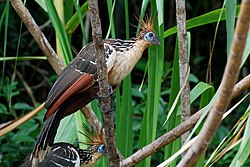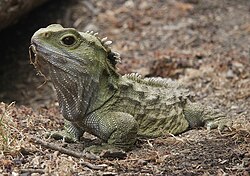Living fossil
Living fossil refers to life forms which have survived with little change for a long time, and which are still around today.
- Horseshoe crabs are a typical case of living fossil. They have changed little in appearance since the Ordovician period, 450 million years ago.
- Crocodilians first appeared 220 million years ago, and are close relatives of the dinosaurs. However, modern crocodiles only date back to the Upper Cretaceous of 84 million years ago.
- Turtles are first known from 215 million years ago, but for some reason they are not often mentioned as living fossils.
- The Tuatara, from New Zealand, is the sole survivor of a whole order of reptiles, the Sphenodontia. 200 million years ago the group (sister to the lizards and snakes) was quite common.
- The Coelacanth is definitely a living fossil. It is the closest link between fish and the first amphibians (408
Living Fossil Media
The coelacanths were thought to have gone extinct 66 million years ago, until a living specimen belonging to the order was discovered in 1938.
Elephant shrews resemble the extinct Leptictidium of Eocene Europe.
Ginkgos not only have existed for a long time, but also have a long life span, with some having an age of over 2,500 years. Six specimens survived the atomic bombing of Hiroshima, 1 to 2 kilometers from ground zero. They still live there today.
Ferns were the dominant plant group in the Jurassic period, with some species, such as Osmunda claytoniana, maintaining evolutionary stasis for at least 180 million years.
Echidnas are one of few mammals to lay eggs.
Hoatzin hatch with two visible claws on their wings, but the claws fall out once the birds reach maturity.
Crocodilians survived the K–Pg extinction event that killed off the non-avian dinosaurs.
Tuatara are reptiles, yet retain more primitive characteristics than lizards and snakes.
The goblin shark is the only extant representative of the family Mitsukurinidae, a lineage some 125 million years old (early Cretaceous).
–362 million years ago). The Coelacanth was thought to have been extinct for 80 million years until one was caught alive off the east African coast in 1938. It is therefore also a Lazarus taxon.
- The Ginkgo tree, Ginkgo biloba, is a good example from the world of plants. It is a gymnosperm. It was thought to be long extinct in the wild, but is now known to grow in at least two small areas in China. The first similar fossils date from the Permian period, 270 million years ago.
- Lingula, a brachiopod, is a genus which has lasted since the Ordovician, 488 million years ago. The modern species are almost the same as the first fossils.
Living fossils are not identical to their ancestors, of course. But they lived in the same or similar environments, and their adaptations suggest that their life-style was the same, or very similar.
| Figure 11.8: Fossil Lingula (left) and modern Lingula (right). | |












